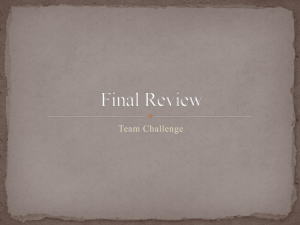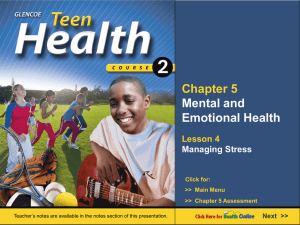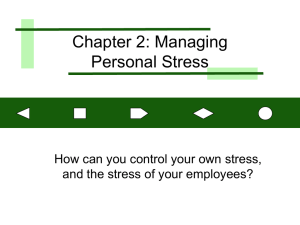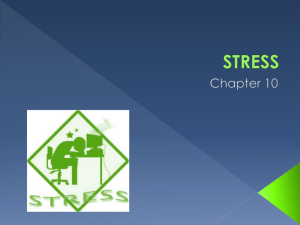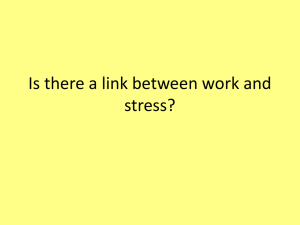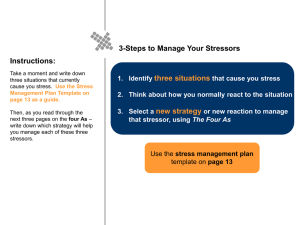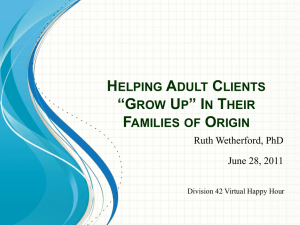An overview of Marriage and Family Counseling
advertisement
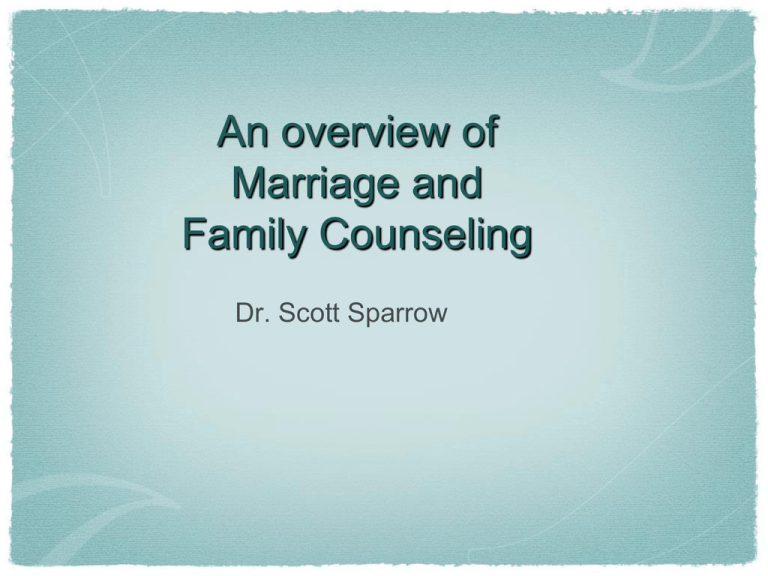
An overview of Marriage and Family Counseling Dr. Scott Sparrow Systems Theory A person is himself or herself in the context of relationships. The usual focus on a person’s feelings, thoughts, and internal struggles will not reveal the relationship forces that create distress or health A relationship is governed by feedback, or circular causality, in which each person continually responds to the other in predictable ways that sustain patterns of interacting in the system. Systems Theory Problems originate in, and are perpetuated by relationship dynamics. Solutions can be found in changing relationship dynamics. Systemic change can occur by intervening or restructuring the patterns of interacting between members School of Family Therapy • MRI Cybernetics -- Bateson, Haley, Jackson • grant to study schizophrenic families • feedback loops • circular causality • rules • Bowen • studied schizophrenic families -- mother child fusion • three-generation model, genogram • fusion and differentiation • triangulation School of Family Therapy, cont. • Strategic -- Haley and Mandanes • paradoxical directives • highly directive without explaining reasons • insight not necessary, still working under the assumption that families resist change • presenting problem needs to be the focus. Once it is resolved, therapy is over • Structural -- Minuchin • boundaries • hiercharchies • enactments • more collaborative than Strategic -- teaching and coaching • presenting problem may mask more important issues, esp. marital School of Family Therapy, cont. • Human Validation Process -- Satir • nurturing • family sculpting, parts party, concrete symbols, touching • focused on teaching direct communication • Experiential Family Therapy -- Whitaker • therapist’s personal involvement essential • highly experimental, playful, creative • confrontive • existentialist Families in Distress All families face two types of stressors Developmental stressors Environmental stressors Families in distress are not sick, but have been unable to adjust to the stressors Developmental Stressors marriage 1st child 1st teenager gender role changes death of parent children leave home Environmental Stressors fire injury war new job or job loss economic recession storm losses Why Families Enter Therapy • Stressors -- environmental and developmental -- arise in the normal course of a family’s life. • The failure of its members to accommodate to stressors leads members to disengage from some members, and become enmeshed with others • Indirectness of communication and anxiety ensues, with triangular relationships substituting for direct encounter and the pursuit of intimacy. • Identified patient is usually reason for entering therapy, but often only the symptom of family distress.. A distressed family Is often unwilling to take responsibility Interprets problems from a linear causality perspective, rather than a circular perspective. Suffers a confusion of levels (children and parents) Forms coalitions (a parent and a child against another parent) Appoints children to quasi-adult roles (a child taking on the role of one parent’s confidant) Rules Matter Families have rules that determine how balance is reinstated. If something violates the rules, then one of two things happen: Members reassert the rules. The family changes the rules. Values Matter Families have values that assign meaning to various events. It is important to understand those values in working with families. Values are a function of family and cultural origins. Language Matters Families have ways of describing people and situations that reflect their values and rules. It is important to understand the way the family uses language, in order to effectively reframe people and situations whenever a more positive viewpoint is possible. Reframing is using language to describe a person or a situation in a more positive way. A Step-by-Step Approach to Family Therapy -- the Initial phase • 1) Inviting entire family to session • 2) Joining and building a collaborative relationship • 3) Assessing problem from multiple perspectives • 4) Assessing family rules, values, language patterns, and goals (teleological lens) • 5) Assessing cultural issues (multicultural lens), and family of origin for patterns across the generations (developmental lens) -- genogram A Step-by-Step Approach to Family Therapy --Interventions • 6) Observing, or tracking interactional patterns -- asking process questions (Bowen) • educates the family about circular causality • I-position encourages taking responsibility and ending of blame • 7) Observing and encouraging typical dynamics -enactments (Minuchin). Therapist may use • Reframing, “stroke and a kick” • Assigning tasks • boundary adjustments • eliciting and supporting competencies Restructuring Concepts • Supporting parents (hierarchies) • Insulating parents from their own families of origins • Insulating parents from children • Establishing direct communication or “Detriangulating” • Nurturing competencies through reframing symptoms as strengths and assigning tasks • Redefining relationships one-to-one with family of origin Classic Problems: Critical/enmeshed parent in-law Acting out teenager Affairs Classic Problems: Critical/enmeshed parent in-law unwillingness of adult child to assert boundaries unwillingness of son/daughter in-law to confront parent directly can lead to carryover of anger of adult child to spouse Interventions: Critical/enmeshed parent in-law Establish better boundaries and privacy between couple and parent Confront in-law by adult child Establish direct relationship between son/daughter in-law and parent in-law (de-triangulation) Classic Problems: Acting out teenager Usually one parent is disengaged from the family The other parent is usually over-involved in the “problem” child’s life. There is a lack of intimacy between couple due to preoccupation with child. There is often a neglect of other children’s needs Interventions: Acting Out Teenager Get couple to work together to resolve differences, clarify rules, and express expectations Reframe teenager’s behavior if possible Encourage direct communication between teenager and disengaged parent(s) without interference Classic Problems: Infidelity Usually occurs during major developmental or environmental stressors, which disrupt communication and intimacy between spouses Can be due to lifelong suppression of one’s needs in the context of a marital relationship Can be due to lack of intimacy due to family pressures Interventions--Affairs Establish that it takes two for an affair to happen. Need to communicate unspoken needs perhaps too much difference or “complementarity” perhaps not enough “similarity,” and quality time explore unexpressed dreams Tools for All Seasons Focus on process (how) rather than content (what) Focus on interpersonal dynamics, rather than personal feelings and thoughts Focus on here and now, vs. there and then Tools for All Seasons Teach Circular Causality/Reciprocity Ask “process questions” that encourage linking one’s own behavior to the effects on others, example: “What effect does it have on her when you withdraw and watch TV?” or “Have you tried to talk with him about it rather than giving him the silent treatment?” Encouraging I-position, not talking about others Explore cross-generational patterns Tools for All Seasons De-triangulating Getting people to talk directly without interruptions Role playing direct communication Having everyone present for meeting Acknowledging competencies and putting them to work Reframing -- “Stroke and Kick” -- Reframe and redirect Genograms for cross-generational patterns Quiz On a scale of 1-10, where 1 is “not at all”, and 10 is “very much or very often,” answer the following: 1. I get along with my partner. 2. I respect my partner. 3. My partner shows respect for me. 4. When I get upset with my partner, I speak my mind openly even if I have to get mad. Quiz 5. My partner and I have a lot in common. 6. My partner and I have different things that we are good at. 7. I have resolved most of my issues with my parents. 8. I find it difficult to take responsibility for my part when things go wrong between me and my partner. 9. There are things in my family’s past that I have a hard time talking about. 10. I tend to be the one that my family comes to when they have a problem with someone else. Quiz Give yourself one point on every question from question #1-7 that you gave yourself a 6 or higher on. Give yourself one point on every question from #8-10 that you gave yourself a 4 or less. So, how healthy are you in relationship? 8-10 very healthy in relationships 5-7 doing pretty well, could use targeted work 3-4 counseling recommended 0-2 counseling strongly recommended ew ofMarriage and Family Counseling Thank you! Dr. Scott Sparrow


